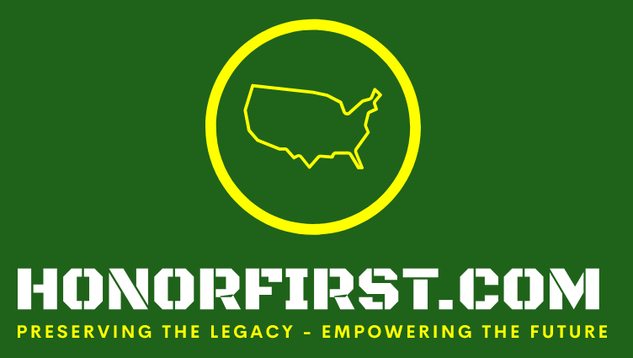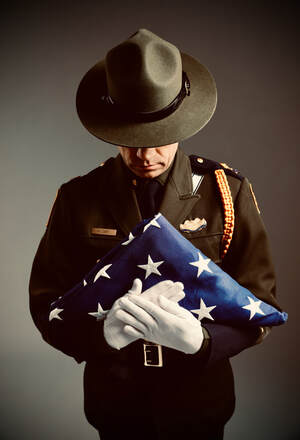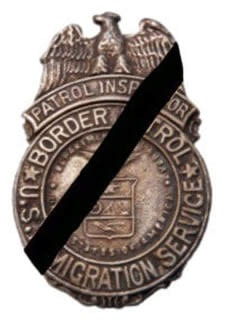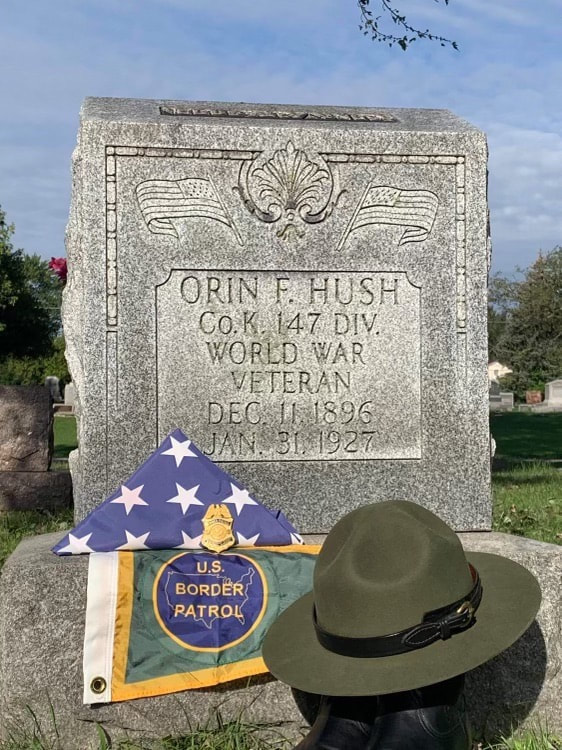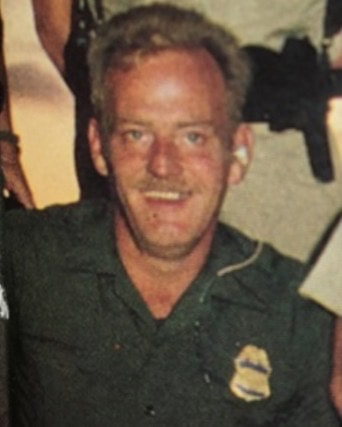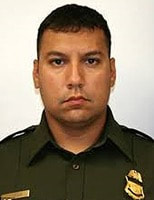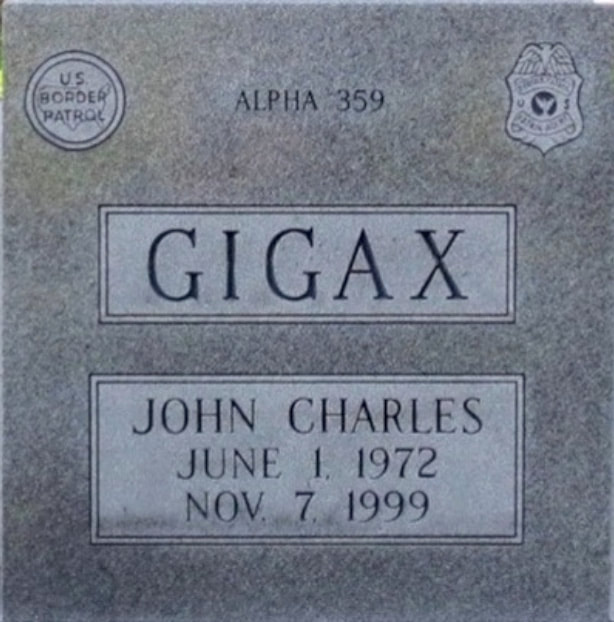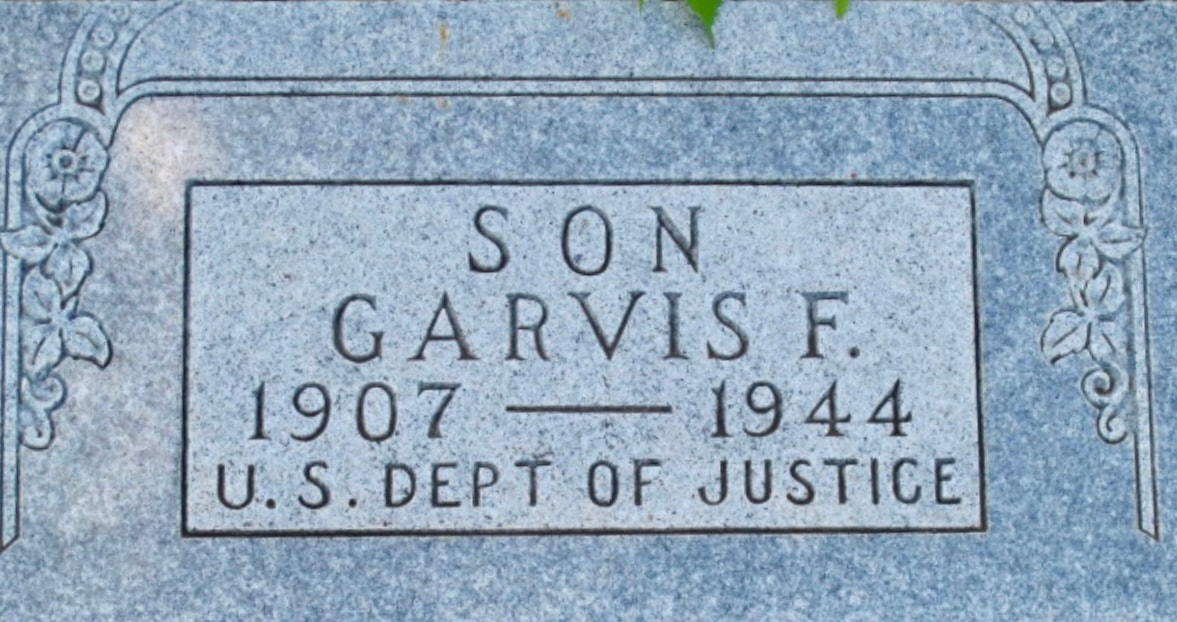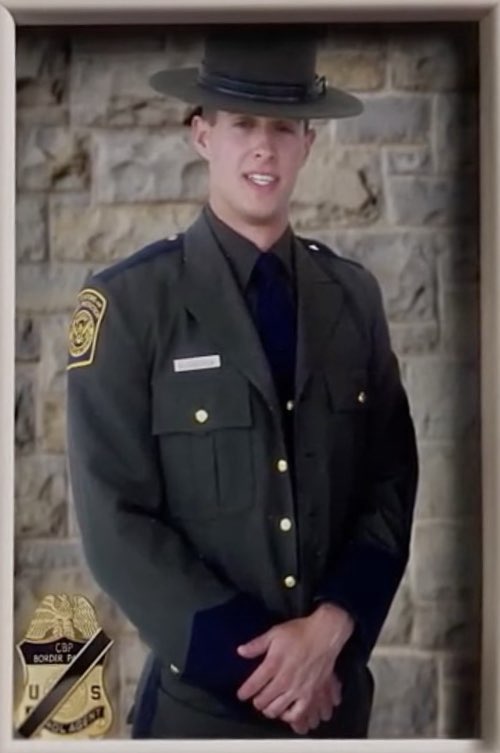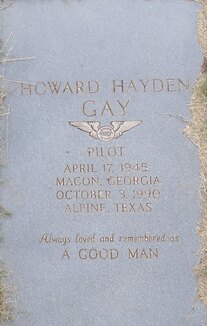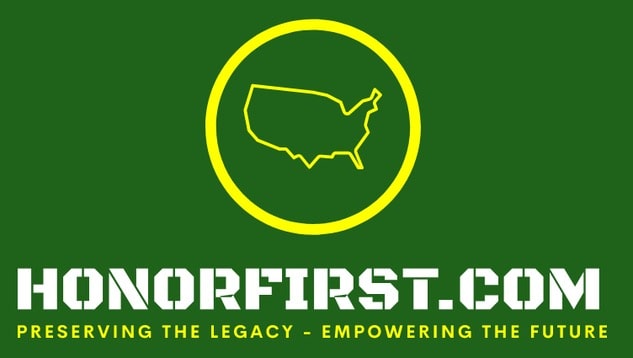Unrecognized But Unforgotten
A Historical Commitment to Honor
Reflecting on our rich history, we recall the words of Chief Patrol Inspector Herbert Horsley from June 3, 1929, addressing the parents of fallen Patrol Inspector Benjamin Hill:
This profound statement, made when our organization was just five years old, sets a high bar for how we honor our heroes. It reminds us to consistently err on the side of recognizing the sacrifices of our fallen agents, ensuring that none are forgotten in the annals of our history.
- We want you to know that your son's name will go down in Border Patrol history as a martyr to the cause of justice and as an example of fearlessness in the enforcement of the Laws of our Country.
This profound statement, made when our organization was just five years old, sets a high bar for how we honor our heroes. It reminds us to consistently err on the side of recognizing the sacrifices of our fallen agents, ensuring that none are forgotten in the annals of our history.
Addressing the Oversight in Honor within the U.S. Border Patrol
In the legacy of the United States Border Patrol and Customs and Border Protection, a shadow lingers over the uncelebrated heroes whose sacrifices have gone unrecognized. This oversight not only misrepresents history but also overlooks the courage and dedication of agents like Patrol Inspector James F. Mankin and others whose stories have been delayed in acknowledgment.
"Unrecognized But Unforgotten" is more than a webpage; it is a beacon calling for change, a spotlight on a significant oversight in how we honor our border security's legacy. We challenge the leadership of the USBP and CBP to correct these historical inaccuracies and to rightly honor every fallen agent.
As you delve deeper into this page, we invite you to join us in this critical mission. Uncover the overlooked stories of USBP inspectors and agents, understand the intricacies of policy, and grasp the urgent need for reform. This isn't just about recounting tales of bravery; it's an active call to reshape how we honor our heroes. Together, we can ensure that the legacy of every inspector and agent who served and sacrificed is not merely remembered but eternally engraved in the annals of our nation's border security history.
"Unrecognized But Unforgotten" is more than a webpage; it is a beacon calling for change, a spotlight on a significant oversight in how we honor our border security's legacy. We challenge the leadership of the USBP and CBP to correct these historical inaccuracies and to rightly honor every fallen agent.
As you delve deeper into this page, we invite you to join us in this critical mission. Uncover the overlooked stories of USBP inspectors and agents, understand the intricacies of policy, and grasp the urgent need for reform. This isn't just about recounting tales of bravery; it's an active call to reshape how we honor our heroes. Together, we can ensure that the legacy of every inspector and agent who served and sacrificed is not merely remembered but eternally engraved in the annals of our nation's border security history.
The Unacknowledged Sacrifices
The Overlooked Heroes of the USBP
In the proud and storied history of the U.S. Border Patrol (USBP), there lies a less told, yet equally important narrative. It's the story of inspectors and agents whose ultimate sacrifices have been overlooked, whose acts of bravery and dedication have not been given the recognition they rightfully deserve. This is dedicated to these heroes, to bring their stories into the light and to honor their memory.
The Mounted Watchmen Paradox
It's notable that the USBP honors the Mounted Watchmen, who served before its formation, yet there remains a gap in recognizing some of its own inspectors and agents. These USBP members, whose deaths are yet to be formally acknowledged as Line of Duty Deaths (LODDs), represent an important part of the Patrol's history. Addressing this paradox is not just about correcting historical records; it's a vital step towards fully honoring the legacy and dedication of all who have served under the USBP banner.
In the proud and storied history of the U.S. Border Patrol (USBP), there lies a less told, yet equally important narrative. It's the story of inspectors and agents whose ultimate sacrifices have been overlooked, whose acts of bravery and dedication have not been given the recognition they rightfully deserve. This is dedicated to these heroes, to bring their stories into the light and to honor their memory.
The Mounted Watchmen Paradox
It's notable that the USBP honors the Mounted Watchmen, who served before its formation, yet there remains a gap in recognizing some of its own inspectors and agents. These USBP members, whose deaths are yet to be formally acknowledged as Line of Duty Deaths (LODDs), represent an important part of the Patrol's history. Addressing this paradox is not just about correcting historical records; it's a vital step towards fully honoring the legacy and dedication of all who have served under the USBP banner.
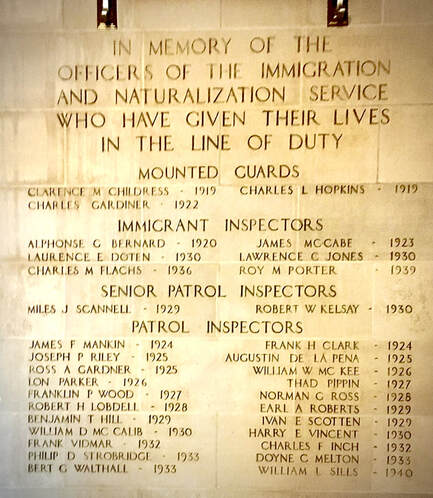
Located in the William Jefferson Clinton West Building, formerly known as the Department of Labor Building, this memorial honors the courageous Immigration and Naturalization Service (INS) and Immigration Border Patrol (USBP) officers. From approximately 1935-1940, this building served as their headquarters. Congress authorized the memorial in 1936 through H.J. Res. 439, making it the earliest known tribute to the INS. Unveiled as a finished product, the Department of Labor, aware of the impending transfer of the INS to the Department of Justice, chose to honor these heroes before the transition. Situated less than 200 feet from the CBP Valor Memorial in the Ronald Reagan Building, it echoes a continued legacy of bravery and sacrifice.
Stories of the Forgotten Who Were Later Remembered
|
|
|
|
The Impact on Families and Colleagues
The delay in recognition deeply affected the families and colleagues of these employees. Before corrected, the testimonials from those who knew them paint a picture of grief compounded by the feeling of their loved ones being forgotten by the very organization they served. The emotional toll of this oversight extends beyond the immediate family, affecting the morale and cohesion within the USBP. It sends a disheartening message to those who currently serve, about how their ultimate sacrifices might be remembered.
A Reflection on Organizational Values
The way we honor our fallen agents is a reflection of our values as an organization. The USBP has a duty to ensure that every inspector and agent who lost their lives in the line of duty is honored appropriately. This is not just about correcting historical inaccuracies; it's about upholding the integrity and ethos of these organizations. It's about showing current and future agents that their sacrifices will be remembered and honored, in line with the noble principles they stood for.
The delay in recognition deeply affected the families and colleagues of these employees. Before corrected, the testimonials from those who knew them paint a picture of grief compounded by the feeling of their loved ones being forgotten by the very organization they served. The emotional toll of this oversight extends beyond the immediate family, affecting the morale and cohesion within the USBP. It sends a disheartening message to those who currently serve, about how their ultimate sacrifices might be remembered.
A Reflection on Organizational Values
The way we honor our fallen agents is a reflection of our values as an organization. The USBP has a duty to ensure that every inspector and agent who lost their lives in the line of duty is honored appropriately. This is not just about correcting historical inaccuracies; it's about upholding the integrity and ethos of these organizations. It's about showing current and future agents that their sacrifices will be remembered and honored, in line with the noble principles they stood for.
Addressing the Discrepancies
The Need for Policy Reform
The Need for Policy Reform
In the esteemed history of the U.S. Border Patrol and CBP, a critical issue stands out: the discrepancy in how we honor the sacrifices of our inspectors and agents. This section focuses on the policy gaps leading to several deserving individuals being overlooked in memorials and acknowledgments.
Critical Comparisons in Recognition: Agents John Charles Gigax, Jose Daniel Barraza, Jesus De La Ossa and Thomas J. Williams
The distinct ways in which the similar deaths of Border Patrol Agents John Charles Gigax, Jose Daniel Barraza, Jesus De La Ossa and Thomas J. Williams have been memorialized posthumously point to notable inconsistencies in the recognition process within the USBP and CBP.
Border Patrol Agent John Charles Gigax (1972-1999) tragically lost his life in an automobile crash on November 7, 1999, in Hanover County, Virginia, while on detail in Washington, D.C. Despite the circumstances of his death in a government vehicle, his death has not been recognized in the CBP or USBP memorials. However, his contribution was honored by Chief Patrol Agent John Montoya, who submitted the application and had Agent Gigax's name inscribed on the National Law Enforcement Officers Memorial.
In contrast, Border Patrol Agent Jose Daniel Barraza (1987-2016), who perished in a vehicle accident near Sierra Blanca, Texas, on April 18, 2016, during his commute home after his shift, is duly commemorated on the CBP Valor Memorial. This formal recognition of Barraza’s sacrifice, compared to the oversight in Gigax's case, underscores a disparity in how the agency honors its fallen agents.
Further, Senior Patrol Agents Jesus De La Ossa (1965-1998) and Thomas J. Williams (1966-1998) both tragically involved in a fatal collision while traveling on duty during a detail, were formally recognized for their sacrifices. This contrast with Agent Gigax’s case, who was also on detail when he met his untimely demise, underscores the inconsistent approaches in honoring our fallen. It emphasizes the pressing need for USBP and CBP to establish uniform, equitable recognition standards, ensuring every line-of-duty sacrifice is rightfully and respectfully acknowledged.
This stark difference emphasizes the urgent need for a uniform and just approach in acknowledging the sacrifices of all agents who die in the line of duty, spotlighting the essential role of USBP and CBP leadership in addressing these inconsistencies in memorial recognitions.
The distinct ways in which the similar deaths of Border Patrol Agents John Charles Gigax, Jose Daniel Barraza, Jesus De La Ossa and Thomas J. Williams have been memorialized posthumously point to notable inconsistencies in the recognition process within the USBP and CBP.
Border Patrol Agent John Charles Gigax (1972-1999) tragically lost his life in an automobile crash on November 7, 1999, in Hanover County, Virginia, while on detail in Washington, D.C. Despite the circumstances of his death in a government vehicle, his death has not been recognized in the CBP or USBP memorials. However, his contribution was honored by Chief Patrol Agent John Montoya, who submitted the application and had Agent Gigax's name inscribed on the National Law Enforcement Officers Memorial.
In contrast, Border Patrol Agent Jose Daniel Barraza (1987-2016), who perished in a vehicle accident near Sierra Blanca, Texas, on April 18, 2016, during his commute home after his shift, is duly commemorated on the CBP Valor Memorial. This formal recognition of Barraza’s sacrifice, compared to the oversight in Gigax's case, underscores a disparity in how the agency honors its fallen agents.
Further, Senior Patrol Agents Jesus De La Ossa (1965-1998) and Thomas J. Williams (1966-1998) both tragically involved in a fatal collision while traveling on duty during a detail, were formally recognized for their sacrifices. This contrast with Agent Gigax’s case, who was also on detail when he met his untimely demise, underscores the inconsistent approaches in honoring our fallen. It emphasizes the pressing need for USBP and CBP to establish uniform, equitable recognition standards, ensuring every line-of-duty sacrifice is rightfully and respectfully acknowledged.
This stark difference emphasizes the urgent need for a uniform and just approach in acknowledging the sacrifices of all agents who die in the line of duty, spotlighting the essential role of USBP and CBP leadership in addressing these inconsistencies in memorial recognitions.
Critical Comparisons in Recognition: Agent Joe R. White, Patrol Inspector Garvis Field Harrell, and Agent Alan Aurigema
Border Patrol Agent Joe R. White (1954-1995): Agent Joe R. White suffered a fatal heart attack while on duty at the IH-35 checkpoint near Laredo on April 18, 1995. With 7 years of service and a notable record as a canine handler, including significant narcotics seizures, White's contributions are honored on the CBP Valor Memorial.
Patrol Inspector Garvis Field Harrell (1907-1944): On April 24, 1944, in Rangerville, Texas, Patrol Inspector Garvis Field Harrell, a month into his service with the U.S. Border Patrol and a World War II veteran, suffered a fatal heart attack during a pursuit. Despite his dedication and the circumstances of his death, Harrell's sacrifice remains unrecognized by both the USBP and CBP.
Border Patrol Agent Alan Aurigema (1987-2023): On April 4, 2023, Agent Alan Aurigema passed away from a coronary blockage while on duty, in uniform, and in a marked vehicle while working in the Casa Grande Station's area of responsibility in Arizona. The extended time taken to locate his body adds to the tragic nature of his death. Despite these circumstances, Aurigema's name has not been added to any USBP or CBP memorials, leading to feelings of frustration and perceived injustice among his colleagues.
The varying degrees of recognition for these three agents – White's inclusion, Harrell's omission, and Aurigema's exclusion – highlight the inconsistencies in how the sacrifices of USBP and CBP agents are commemorated. These contrasting cases emphasize the urgent need for a consistent and equitable approach in recognizing the service and sacrifice of all agents who die in the line of duty, ensuring they are all honored with the dignity and respect they deserve.
Border Patrol Agent Joe R. White (1954-1995): Agent Joe R. White suffered a fatal heart attack while on duty at the IH-35 checkpoint near Laredo on April 18, 1995. With 7 years of service and a notable record as a canine handler, including significant narcotics seizures, White's contributions are honored on the CBP Valor Memorial.
Patrol Inspector Garvis Field Harrell (1907-1944): On April 24, 1944, in Rangerville, Texas, Patrol Inspector Garvis Field Harrell, a month into his service with the U.S. Border Patrol and a World War II veteran, suffered a fatal heart attack during a pursuit. Despite his dedication and the circumstances of his death, Harrell's sacrifice remains unrecognized by both the USBP and CBP.
Border Patrol Agent Alan Aurigema (1987-2023): On April 4, 2023, Agent Alan Aurigema passed away from a coronary blockage while on duty, in uniform, and in a marked vehicle while working in the Casa Grande Station's area of responsibility in Arizona. The extended time taken to locate his body adds to the tragic nature of his death. Despite these circumstances, Aurigema's name has not been added to any USBP or CBP memorials, leading to feelings of frustration and perceived injustice among his colleagues.
The varying degrees of recognition for these three agents – White's inclusion, Harrell's omission, and Aurigema's exclusion – highlight the inconsistencies in how the sacrifices of USBP and CBP agents are commemorated. These contrasting cases emphasize the urgent need for a consistent and equitable approach in recognizing the service and sacrifice of all agents who die in the line of duty, ensuring they are all honored with the dignity and respect they deserve.
The Overlooked Sacrifice Border Patrol Pilot Howard H. Gay
The case of Border Patrol Pilot Howard H. Gay (1945-1990) brings this issue into sharper focus. Despite being awarded the highest honor of the Newton-Azrak Award for his valorous action in which he lost his life near Maria, Texas, October 3, 1990. His sacrifice is not equally memorialized, revealing a disconnect between recognition and reality, his death isn't memorialized by being etched in the glass of the CBP Valor Memorial.
The case of Border Patrol Pilot Howard H. Gay (1945-1990) brings this issue into sharper focus. Despite being awarded the highest honor of the Newton-Azrak Award for his valorous action in which he lost his life near Maria, Texas, October 3, 1990. His sacrifice is not equally memorialized, revealing a disconnect between recognition and reality, his death isn't memorialized by being etched in the glass of the CBP Valor Memorial.
Advocating for Compassionate Policy Approaches in Line of Duty Death Determinations
The stark inconsistencies in recognizing line of duty deaths, amplified in the wake of COVID-19 and echoed in the cases of Agents John Charles Gigax, Garvis Field Harrell, Alan Aurigema, and Border Patrol Pilot Howard H. Gay, demand a shift towards more compassionate and equitable policies. These inspectors and agents, whose sacrifices are mired in ambiguity, remind us that our duty transcends legalistic justice. It calls for a profound empathy and unwavering respect, ensuring that every agent's sacrifice is honored, even amidst uncertainty. We owe it to our agents and their families to approach each case not just with fairness but with a heart that recognizes the depth of their sacrifice.
Proposal for a Dedicated LODD Review Board
Reflecting on the insightful contributions of retired Deputy Chief Patrol Agent and historianJoseph Banco , we advocate for the establishment of a specialized Line of Duty Death (LODD) review board for the unrecognized. This board, comprising members from the National Border Patrol Museum, retired Chief Patrol Agents with relevant sector experience, or personnel with USBP historical expertise, would be tasked with examining cases of historically overlooked agents. This approach not only embraces our commitment to honoring every hero but also leverages the unique perspectives and experiences of those deeply familiar with the Border Patrol's heritage. By adopting this inclusive and historically informed approach, we take a significant step towards rectifying past oversights and ensuring that every agent's sacrifice is acknowledged with the dignity it deserves.
Policy Analysis: Where Changes are Needed
The distinction between "on-duty" and "in-the-line-of-duty" deaths creates significant disparities, failing to encompass the true essence of sacrifice and service. A revision of these policies is vital for inclusive and respectful acknowledgment.
The Human Impact of Policy Shortcomings
Unacknowledged sacrifices carry stories of personal loss. Families and colleagues bear the emotional toll of these gaps. The absence of names like Agent Gigax's at CBP's Police Week, despite other honors, amplifies their pain.
A Unified Call for Change
We urge readers, community members, and policy-makers to advocate for reforms ensuring every fallen USBP hero is honored with dignity and respect. Actionable steps include contacting policy-makers and raising public awareness to create a just and respectful recognition system.
The Human Cost of Policy Gaps
Beyond administrative procedures, the recognition practices of the USBP and CBP profoundly impact the lives they touch. This section sheds light on personal narratives, underscoring the emotional toll and broader implications of these policy gaps.
Stories of Loss and Neglect
The Ripple Effect on Morale and Cohesion
These oversights resonate within the USBP and CBP communities. Testimonials from frontline agents highlight how the absence of proper recognition affects their perception of the organization and their role in it, impacting overall morale and cohesion.
Reflecting on Organizational Values
In how we honor our fallen, our values are reflected. The current gaps in recognition pose questions about our commitment to the principles these agents upheld. Emphasizing the USBP and CBP's duty of remembrance is not merely tradition but a crucial aspect of trust and respect within the ranks and with the families who have made the ultimate sacrifice.
Stories of Loss and Neglect
- The story of Agent John Charles Gigax, and the struggle of his parents, Don and Margarita Gigax, brings a deeply personal dimension to the narrative. For over a decade, they attended Police Week in D.C., where Charlie's sacrifice was never officially acknowledged by the Patrol, an omission felt deeply by them.
- Agent Alan Aurigema’s story, overlooked despite his on-duty passing, resonates with feelings of frustration and injustice, shared by his colleagues.
The Ripple Effect on Morale and Cohesion
These oversights resonate within the USBP and CBP communities. Testimonials from frontline agents highlight how the absence of proper recognition affects their perception of the organization and their role in it, impacting overall morale and cohesion.
Reflecting on Organizational Values
In how we honor our fallen, our values are reflected. The current gaps in recognition pose questions about our commitment to the principles these agents upheld. Emphasizing the USBP and CBP's duty of remembrance is not merely tradition but a crucial aspect of trust and respect within the ranks and with the families who have made the ultimate sacrifice.
Honoring the Sacrifice
Advocacy, Resources, and Conclusion
Advocacy, Resources, and Conclusion
Our narratives and discussions unveil the profound human impact of overlooked sacrifices. This journey is about our shared responsibility for recognition and reform.
Advocacy: How You Can Make a Difference
Advocate for policy changes by contacting USBP and CBP leadership. Key contact: CBP Survivor Advocate at [email protected]. Engage in community events to raise awareness.
Resources for Further Exploration
Delve deeper into the history and advocacy efforts within the USBP through these compelling blog posts:
These resources provide valuable insights into the ongoing challenges and efforts to honor the sacrifices of our agents with the dignity they deserve.
The Cases That Need Revisiting
We spotlight the stories of Agents John Charles Gigax, Garvis Field Harrell, Alan Aurigema, and Border Patrol Pilot Howard H. Gay. Their stories are not just histories; they are enduring calls for justice. Each name represents a family's unhealed wound, a community's plea for acknowledgment. Their overdue recognition is vital, a step towards healing and upholding the honor of the USBP and CBP.
Conclusion: A Unified Call for Change
This is more than remembrance; it's a call for action and integrity. Join us in championing the cause to ensure every fallen hero is remembered and honored appropriately. We urge the USBP and CBP leadership and community members to embody the values these agents lived and died for. Their stories deserve more than silence; they demand our collective voice for change.
Advocacy: How You Can Make a Difference
Advocate for policy changes by contacting USBP and CBP leadership. Key contact: CBP Survivor Advocate at [email protected]. Engage in community events to raise awareness.
Resources for Further Exploration
Delve deeper into the history and advocacy efforts within the USBP through these compelling blog posts:
- "This Week in USBP History, Vol. 62": Highlights the story of Border Patrol Agent John Charles Gigax, emphasizing the need for proper recognition within the USBP and CBP. Read more
- "This Week in USBP History, Vol. 86": Discusses policy discrepancies in recognizing fallen agents and includes a persuasive email sent to the CBP Survivor Advocate. Explore here
- "This Week in USBP History, Vol 89": Covers a mix of historical events and current advocacy efforts related to the recognition of fallen agents, with a focus on policy reforms. Discover more
These resources provide valuable insights into the ongoing challenges and efforts to honor the sacrifices of our agents with the dignity they deserve.
The Cases That Need Revisiting
We spotlight the stories of Agents John Charles Gigax, Garvis Field Harrell, Alan Aurigema, and Border Patrol Pilot Howard H. Gay. Their stories are not just histories; they are enduring calls for justice. Each name represents a family's unhealed wound, a community's plea for acknowledgment. Their overdue recognition is vital, a step towards healing and upholding the honor of the USBP and CBP.
Conclusion: A Unified Call for Change
This is more than remembrance; it's a call for action and integrity. Join us in championing the cause to ensure every fallen hero is remembered and honored appropriately. We urge the USBP and CBP leadership and community members to embody the values these agents lived and died for. Their stories deserve more than silence; they demand our collective voice for change.
Join Our Mission to Honor the Unrecognized Heroes of the USBP and CBP
At HonorFirst, we're committed to shining a light on the overlooked and unacknowledged heroes of the U.S. Border Patrol and Customs and Border Protection. If you know of an agent, inspector or officer whose sacrifice has gone unrecognized, or if there's a fallen hero whose story echoes another's, we invite you to share their story here. Your contribution can help us ensure that every hero's legacy is remembered and honored. Let's work together to correct the oversight in our history and give due recognition to those who have served with valor and dedication.
Please feel free to share your stories and thoughts in the comment box below. Let's keep the memories of our heroes alive and ensure that none are forgotten.
Please feel free to share your stories and thoughts in the comment box below. Let's keep the memories of our heroes alive and ensure that none are forgotten.
